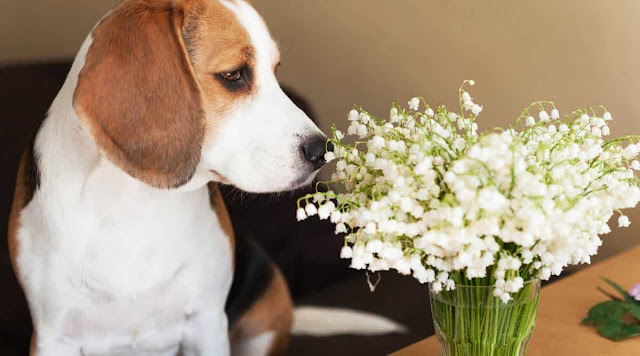Lily of the Valley, with its delicate and fragrant bell-shaped flowers, is a common garden plant cherished for its ornamental beauty. However, beneath its charming exterior lies a potential danger, especially for our furry friends. If you're a dog owner, understanding the toxicity of Lily of the Valley and knowing what to do if your dog ingests it is crucial for their well-being. In this comprehensive guide, we'll explore why Lily of the Valley is poisonous to dogs, the signs of toxicity, and the immediate steps to take if ingestion occurs.
Why is Lily of the Valley Poisonous to Dogs?
Lily of the Valley (Convallaria majalis) contains cardiac glycosides, which are toxic compounds that affect the heart and can lead to serious health issues in both humans and animals. These glycosides, specifically convallatoxin and convallarin, can cause an array of symptoms when ingested by dogs.
Signs of Lily of the Valley Poisoning in Dogs:
Vomiting:
One of the initial signs of Lily of the Valley poisoning in dogs is vomiting. This occurs as the body attempts to expel the toxic compounds.
Diarrhea:
Diarrhea may accompany vomiting, leading to dehydration. It is crucial to monitor your dog's fluid intake and ensure they stay hydrated.
Increased Heart Rate (Tachycardia):
Cardiac glycosides affect the heart, leading to an increased heart rate. Monitoring your dog's pulse can provide valuable information if you suspect ingestion.
Drooling and Nausea:
Dogs may exhibit signs of nausea, including excessive drooling, as a result of Lily of the Valley toxicity.
Abdominal Pain:
Dogs may show signs of abdominal discomfort or pain, such as restlessness or reluctance to lie down.
Seizures:
In severe cases, Lily of the Valley poisoning can lead to seizures. Seizures require immediate veterinary attention.
Collapse or Loss of Consciousness:
If the toxicity progresses, it can lead to weakness, collapse, or even loss of consciousness. These are severe symptoms that warrant emergency intervention.
What to Do if Your Dog Eats Lily of the Valley:
Contact Your Veterinarian Immediately:
If you suspect or witness your dog ingesting Lily of the Valley, contact your veterinarian or the nearest emergency animal poison control center immediately. Provide details about the plant, the amount ingested, and your dog's current symptoms.
Do Not Wait for Symptoms:
Lily of the Valley toxicity can be rapid and severe. Even if your dog is not showing immediate symptoms, do not wait for them to appear before seeking professional help.
Induce Vomiting (Under Veterinary Guidance):
In some cases, your veterinarian may instruct you to induce vomiting at home. However, this should only be done under veterinary guidance, as inducing vomiting in the wrong circumstances can be harmful.
Keep a Sample of the Plant:
If possible, keep a sample of the Lily of the Valley plant or take a clear photograph for identification. This can assist the veterinarian in confirming the plant's toxicity.
Transport to the Vet:
If advised by your veterinarian, transport your dog to the clinic immediately. Do not delay, as prompt medical attention is crucial.
Supportive Care:
Treatment may include supportive care such as intravenous fluids to maintain hydration, medications to control vomiting, and cardiac monitoring to address any heart-related issues.
Prevention and Safety Measures:
Identify and Remove Lily of the Valley:
Familiarize yourself with the appearance of Lily of the Valley and ensure it is not present in areas accessible to your dog. If you have this plant in your garden, consider removing it or placing it in an area your dog cannot reach.
Supervise Outdoor Activities:
Always supervise your dog during outdoor activities, especially in areas where Lily of the Valley may grow. Promptly discourage your dog from investigating or nibbling on unfamiliar plants.
Educate Family Members and Visitors:
Make sure that everyone in your household and visitors are aware of the potential toxicity of Lily of the Valley. Encourage them to report any sightings of the plant to prevent accidental ingestion.
Consider Alternative Plants:
If you enjoy gardening, consider selecting dog-friendly plants for your outdoor space. Many beautiful plants are non-toxic to dogs and can be a safer choice.
Training and Recall Commands:
Train your dog to respond to recall commands, which can be crucial in redirecting their attention away from potentially harmful plants during outdoor activities.
Conclusion:
While Lily of the Valley adds charm to gardens with its dainty blossoms, its potential toxicity to dogs underscores the importance of awareness and preventive measures. Understanding the signs of Lily of the Valley poisoning and taking immediate action in case of ingestion can make a significant difference in your dog's outcome. Quick and informed responses, such as contacting your veterinarian and seeking professional guidance, are vital steps in safeguarding your furry friend's health.
Prevention remains the most effective approach, and pet owners play a key role in creating a safe environment for their dogs. Regularly inspect your surroundings, eliminate or secure access to toxic plants, and educate those around you about potential dangers. Responsible pet ownership involves not only providing love and care but also being vigilant about potential hazards in your pet's environment.
In the event of Lily of the Valley ingestion, remember that time is of the essence. Delaying action can lead to severe consequences. By staying informed, taking preventative measures, and acting promptly if an incident occurs, you contribute to creating a safer and healthier life for your beloved canine companion.
Always consult with your veterinarian for personalized advice tailored to your dog's specific needs and circumstances. With proper awareness and proactive measures, you can enjoy a beautiful garden without compromising your pet's well-being.




.jpeg)








.jpeg)



0 Comments